| Article ID | Journal | Published Year | Pages | File Type |
|---|---|---|---|---|
| 3046276 | Clinical Neurophysiology | 2009 | 9 Pages |
ObjectiveTo assess the genetic and environmental influences on the inter-individual variability of spectral EEG parameters under two conditions of reduced visual input in preschoolers.MethodsEEG was recorded in 21 monozygotic and 20 same-sex dizygotic twin pairs aged 5–6 years under the Closed eyes and Darkness conditions. The contributions of genetic and environmental influences to individual EEG parameters were estimated using structural equation modeling.ResultsThe alpha rhythm parameters – both spectral amplitude and frequency – were influenced mainly by genetic factors. Theta spectral amplitude variance was presumably accounted for by both genetic and shared environmental factors. The difference in the nature of population variance between EEG alpha and theta band spectral amplitudes was reproduced for two identical functional loads: Closed eyes and Darkness.ConclusionsThe majority of EEG spectral parameters in preschool children are determined by genetic factors. Tentative finding on systematic environmental influences on theta spectral amplitude under the condition of reduced visual input may point to the role of experience in the individual differences in the functioning of theta response system.SignificanceThe findings contribute to the scanty knowledge about the heritability of EEG rhythms in preschool children.
